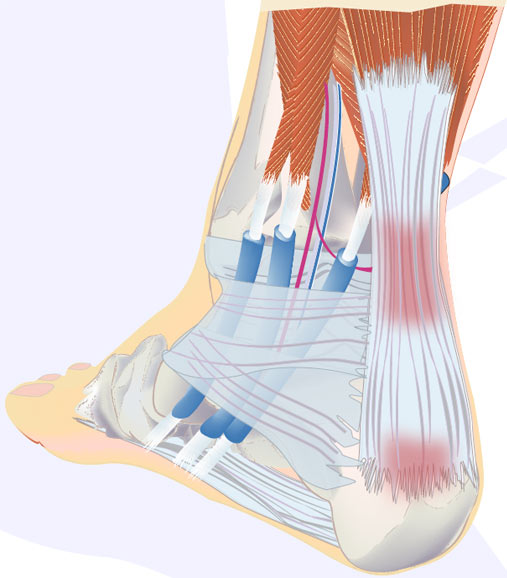Achilles Tendonitis
What Causes the Pain?
Achilles tendonitis occurs when the tendon has been overstressed or overworked. This is usually caused by sports, especially if an athlete suddenly changes the intensity or amount of exercise. Tight calf muscles and lack of flexibility to the calf and ankle can also cause stress to the tendon and over stretch it. As we get older, our tendons become less flexible, which is why middle-age athletes tend to be more susceptible to Achilles tendonitis. Poor athletic equipment or a sudden change in footwear can also cause Achilles tendonitis. Overuse is a major factor seen in runners who add too much mileage to their runs too quickly or for those who frequent hill training. And lastly, poor running form can also aggravate the achilles - typically due to overstriding.
Other conditions can cause Achilles tendonitis as well. A bone spur can rub against the tendon, causing inflammation and pain. Inefficient foot anatomy such as flat foot can also put additional strain on the Achilles, leading to inflammation.
What are the symptoms? What does it feel like?
Heel pain that starts slowly and worsens over time is a common sign of Achilles tendonitis. The pain may even extend to the back of the leg. Pain along the Achilles that is worse when running or after physical activity is also a common symptom. Often patients may feel stiffness or tenderness in the mornings after waking up, which may improve as you start going about you day. There may also be mild swelling around the heel that gets worse with activity.
What is the Treatment?
As with any injury, your doctor will be the best source of advice on the appropriate treatment method for your situation. Achilles tendonitis treatment often includes the RICE method - rest, ice, compression, and elevation. These four principles will help reduce pain, inflammation, and swelling. Anti-inflammatory medications such as ibuprofen or aspirin may also be used to speed up recovery and reduce pain.
Your doctor may also suggest physical therapy. The goal of physical therapy is to show you calf and heel stretches that help with the flexibility of the Achilles. They may also show you exercises known as "eccentric strengthening", which can help treat chronic tendon problems. By incorporating stretching, strength-training and foam rolling into your routine, you can help prevent this annoying injury.
As you return to activity, your doctor may suggest orthotics or an ankle brace to help support your Achilles tendon and to prevent the condition from reoccurring. The Aircast Airheel offers support for Achilles Tendinitis. It helps cushion the Achilles while providing pulsating compression to reduce swelling. It fits anatomically around your heel for support.
Severe achilles tendinitis will require rest and your physician may encourage you to prevent too much weight on your injured foot. In this case, your physician may suggest wearing a walking boot to help provide the support you need as you recover.
SUPPORT & PROTECTION FOR ACHILLES TENDONITIS
View All Achilles Tendonitis Support Options
-
 $33.71On Sale 0% Off Save $0.00(61) ReviewsRevolutionary heel support that cushions and stabilizes with every step. Lightweight design delivers targeted compression and comfort all day long. Protect your ankle, reduce pain, and stay active without limits.
$33.71On Sale 0% Off Save $0.00(61) ReviewsRevolutionary heel support that cushions and stabilizes with every step. Lightweight design delivers targeted compression and comfort all day long. Protect your ankle, reduce pain, and stay active without limits.The Airheel Arch & Heel Support can be used to treat or prevent the following ankle injuries:
- Airheel Arch & Heel Support
- Achilles Tendonitis
-
 $121.07On Sale 0% Off Save $0.00(10) ReviewsExperience elite ankle and foot support with the Aircast AirSelect Elite walking boot. Advanced Aircell technology provides superior comfort, stability, and faster injury recovery. Perfect for fractures, sprains, and post-surgical protection—move confidently every step.
$121.07On Sale 0% Off Save $0.00(10) ReviewsExperience elite ankle and foot support with the Aircast AirSelect Elite walking boot. Advanced Aircell technology provides superior comfort, stability, and faster injury recovery. Perfect for fractures, sprains, and post-surgical protection—move confidently every step.





 The Achilles tendon is the largest tendon in the human body. It connects your heel bone (calcaneus) to your calf muscles and is used when walking, running, and jumping. Achilles tendonitis, also known as Achilles tendinitis, occurs when the Achilles tendon becomes inflamed or aggravated. There are two types of Achilles tendonitis - noninsertional and insertional. Noninsertional Achilles tendonitis occurs in the middle area of the tendon which is slightly above the heel, and typically affects athletes and younger individuals. Insertional Achilles tendonitis can occur in any patient, even patients who are not active and occurs on the lower portion of the heel.
The Achilles tendon is the largest tendon in the human body. It connects your heel bone (calcaneus) to your calf muscles and is used when walking, running, and jumping. Achilles tendonitis, also known as Achilles tendinitis, occurs when the Achilles tendon becomes inflamed or aggravated. There are two types of Achilles tendonitis - noninsertional and insertional. Noninsertional Achilles tendonitis occurs in the middle area of the tendon which is slightly above the heel, and typically affects athletes and younger individuals. Insertional Achilles tendonitis can occur in any patient, even patients who are not active and occurs on the lower portion of the heel.






